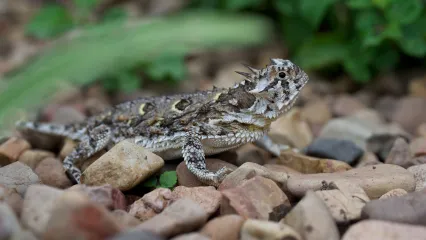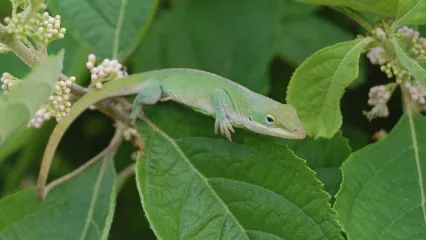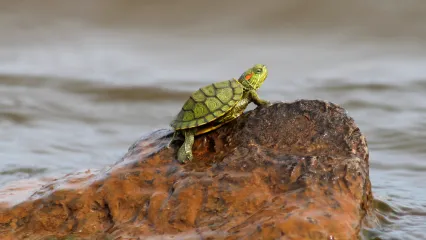
Description
The Texas horned lizard can be easily distinguished from all other Oklahoma lizards by a combination of a short, squat body; two very large “horns” at the back of the head followed by two smaller ones on each side; a short, pointed tail; a distinct thin white line centered on the back and extending from the neck to the tip of the tail; and a double series of enlarged and pointed scales dividing the dorsal body surface from the ventral surface. The “horns” do not contain bone but are actually specialized body scales that serve to protect the lizards from predators. Dorsal body color is variable, often red, brown, or gray, with irregular markings rendering the lizards cryptic against a variety of backgrounds. The belly is cream-colored. Males and females have few external differences except that males have visible pores along the lower hind surface of each thigh and a slight swelling at the base of the tail.
Size
Adult females reach about 5 inches in snout-vent length, but males are smaller, reaching only about 3.7 inches. Recently hatched juveniles are about three-quarters of an inch in snout-vent length.
Habitat
Texas horned lizards occur in all but the southeast corner of Oklahoma, but typically in open areas. Their North American distribution extends from southeastern Arizona east to south-central Arkansas and north from central Kansas south into Mexico. These lizards are adaptable to a wide range of conditions. As a general trend, horned lizards seem to be most common in habitats with sandy or loamy soils, and moderate grass or shrub cover.
Life Cycle
Texas horned lizards are active in Oklahoma from early April through September. In October, they burrow underground to begin their winter hibernation. During the active season, they are usually found in open areas with sandy soil. Females deposit clutches of eggs (that vary in number with size of the female) in a slanted tunnel approximately 6-8 inches into the ground. Smaller females may produce clutches with more than 40 eggs. Hatching occurs in August, and hatchlings are about the size of a quarter when they emerge from eggs. The female provides no further care for her eggs or young and is not likely to lay more eggs that year. Individuals reach sexual maturity in the second year of life.
Most of the diet consists of harvester ants; other insects such as beetles and spiders are eaten as well. Texas horned lizards lie motionless along harvester ant trails and capture ants as they pass to and from their colony. When an ant approaches, the lizard takes a few quick steps forward, flicks out its tongue, captures its prey and swallows it whole. Behavioral observations have shown that horned lizards may eat as many as 70 harvester ants a day. Horned lizards usually attack solitary ants several yards away from the harvester ant colony, and avoid the colony’s center where they would be mobbed by droves of biting ants. Avoiding predators influences many of the Texas horned lizard’s behavioral and physical adaptations.
Though capable of running quickly for short distances, they rely more on camouflage than speed for protection. Their first line of defense is their mottled brown body coloration that helps hide them against bare soil and dead leaves. For further camouflage, local populations tend to resemble the color of their area’s soil. Populations in areas of sandy soil may have a yellowish tint while populations in other areas may have a reddish or dark brown tint. The body shape is also an adaptation to avoid the attention of would-be predators. When lying against the soil, the flattened body casts only a slight shadow, and the spines on the back and sides help break up the body’s outline. A motionless horned lizard is difficult to see against bare soil.
Texas horned lizards (and some other species of horned lizards) have a fascinating behavior used to detract predators. When grasped, they close their eyes and the eyelids appear to inflate. They then squirt a directed stream of blood from the sinuses in their eye cavity toward the would-be predator. Experiments have shown that the blood is distasteful and repels some predators, canids (coyotes) in particular. Chemicals in the blood that produce the bitter taste may be derived from the ants they eat. Little information is available on their normal lifespan, but horned lizards can live at least five years.
How To Observe
During spring and early summer, Texas horned lizards can be observed in their habitat by slowly driving paved and unpaved roads in mid- to late morning. The lizards frequently bask in the sun on roads. During much of the summer, they can be found by walking on unpaved roads or in open areas either early in the morning or late in the afternoon when the sun is close to the horizon. Because they are cryptically colored and usually do not move, Texas horned lizards are often difficult to detect.
Report Texas Horned Lizard Sighting
(This profile was developed in part by Dr. Laurie Vitt as part of a partnership between the Wildlife Department and the Sam Noble Oklahoma Museum of Natural History. It was funded as part of a larger State Wildlife Grant to survey and inventory amphibians and reptiles of the Wildlife Management Areas of Oklahoma: T-35-P-1.)


